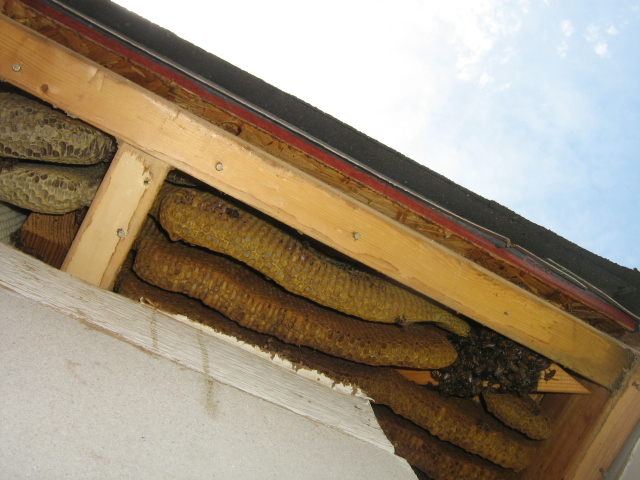
A few bees entering a home usually means a nest is somewhere inside. This colony in a roof soffit likely consists of 30,000 or more bees. The unpredictability of bees means that a normally peaceful nest can turn dangerous quickly.
While honey bees are highly beneficial to man, they can also be dangerous. If you don’t believe this, consider two Texas incidents this summer. In June, a Waco area man was killed by honey bees while working on his tractor. This past weekend a couple was severely stung and two of their miniature horses were killed following a bee attack at their Tarrant county home. Both incidents illustrate how serious honey bee infestations can be.
It’s not that bees are mean, in a human sense. But they do take exception to any people or animals that threaten their nest, or colony.
So what should you do if you are attacked by bees?
- Run! Some people make the mistake of standing in place and swatting bees, but this only gives bees more time to recruit from the colony, and results in more stings. Get to shelter as quickly as you can. Get in a car or building that can be securely shut. If you encounter stinging bees and are a long way from shelter, try to run through shrubs or brush to distract the bees. If there is no shelter nearby, keep running until you leave the bees behind. Some bees may pursue victims a half mile or more before giving up the chase.
- Don’t be fooled into seeking escape in water. According to the Fort Worth Star Telegram article, after failing to swat and swipe off the bees, the Tarrant county couple tried diving in their pool. “We were trying to stand up in the water but every time we stuck our heads out for air, they would cover us and start stinging us,” she said. “We were trying to breathe and they were stinging us in the face and in the nose.” Water is a poor shelter from bee attack.
- Once you’ve escaped the swarm, remove any stingers from your skin as soon as possible. Honey bees are one of the only stinging insects that leaves its stinger in the skin. Left in the skin, the accompanying venom sac will continue to pump venom. Pull the stingers out with a knife blade scraped gently across the skin, or by scraping off with your finger nails.
- Seek medical attention immediately, especially if you experience hives, swelling around the throat or face, or difficulty breathing. While an average healthy adult may able to withstand hundreds of bee stings, for people with bee venom allergies even a single sting can be highly dangerous.
Honey bee attacks have received more media attention since Africanized honey bees entered the country in the early 1990s. Africanized bees, while physically identical to domesticated European bees first brought by settlers to this country about 300 years ago, are genetically predisposed to be more aggressive than the European bee. Africanized bees typically have a lower tolerance for nest disturbance, will send more bees out in pursuit of an intruder, and will chase victims further than their European cousins.
All wild bee colonies in Texas should be assumed to be a hybrid between Africanized and European wild bees. Beekeepers usually ensure that their colonies are founded on the more docile European bees, so the threat from domesticated bees is less than wild bees.
All of this is good reason to be wary of any wild honey bee nest in your home or on your property. A licensed beekeeper or pest control professional can help you get rid of bees. For more information, see our publication E-346, Honey bee control in and around homes.